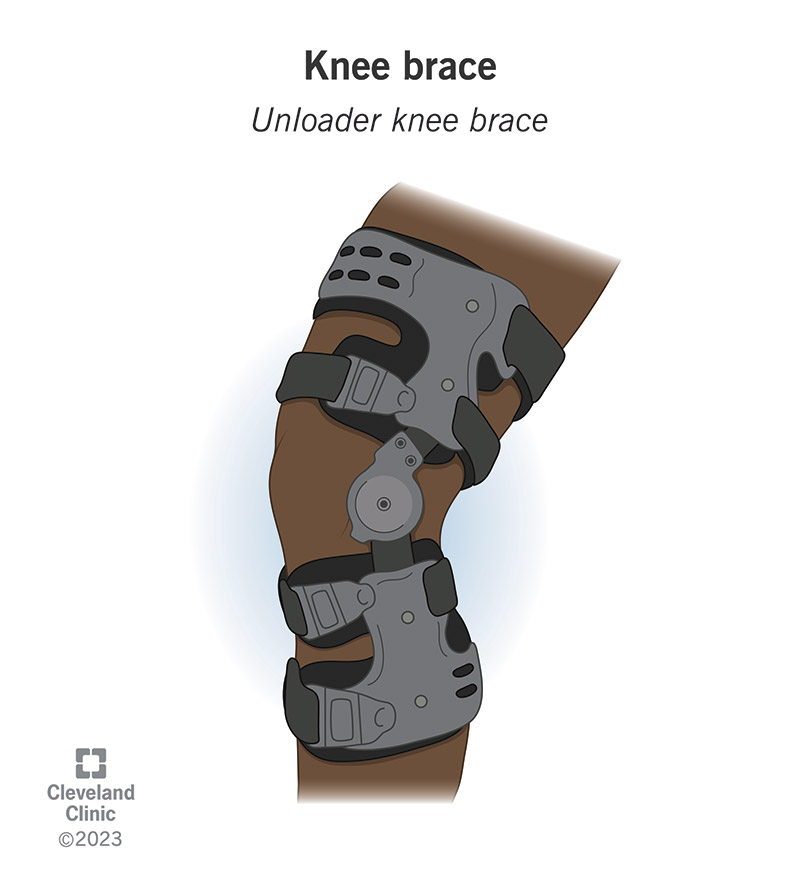Knee braces come in lots of types, shapes and sizes. They support your knee and take pressure off your joint. Visit a healthcare provider if you’re feeling new or worsening knee pain. They’ll diagnose what’s causing it and suggest the right type of brace.
Advertisement
Cleveland Clinic is a non-profit academic medical center. Advertising on our site helps support our mission. We do not endorse non-Cleveland Clinic products or services. Policy

A knee brace is a medical device that stabilizes your knee joint and holds it in place. Healthcare providers use braces to protect and support your knee after an injury. You might have to wear knee support after knee surgery. Providers sometimes call them orthoses.
Advertisement
Cleveland Clinic is a non-profit academic medical center. Advertising on our site helps support our mission. We do not endorse non-Cleveland Clinic products or services. Policy
There are lots of reasons you may need to wear a knee brace. Some examples include:
Your provider might suggest a knee brace to reduce your risk of sports injuries. Some people can wear a brace to help manage knee pain.
Wearing a knee brace isn’t a good substitute for seeing a healthcare provider. Visit a provider before buying or wearing one. They’ll diagnose any injuries or issues. And they’ll help you choose the right type of brace if you need one.
A knee brace supports your knee and holds it in place. It keeps your knee in alignment. Braces are usually made of stiff plastic or metal. They have cushions and straps that wrap around your knee and leg.
A knee brace helps you avoid putting too much stress on your knee joint. It keeps your knee from moving too far or too suddenly. How much resistance and support a brace gives depends on which type you need.
The most common types of knee brace include:
Advertisement
Your healthcare provider will tell you where you can get a knee brace. You might need it custom-fitted. Some braces are available over-the-counter or at retail stores. Other types are only available with a prescription.
Most knee braces fit around your knee with stretchy elastic or Velcro® straps. The brace should be snug and secure without being too tight. It shouldn’t hurt or feel like it’s cutting off circulation to your leg.
It might feel strange or like the brace is pushing your knee into alignment. Especially at first. But it should never hurt or make knee pain worse. Talk to your healthcare provider or physical therapist before wearing a new brace. They’ll help you get used to putting it on, wearing it and moving with it.
Knee braces are a quick, easy way to support your knee joint. They may relieve symptoms like pain and stiffness. They can also help you heal safely. And they can help you feel safer and more confident. Many people also find that wearing a knee brace helps relieve pain and other symptoms, especially if they have knee arthritis.
But a brace may not help. There haven’t been studies that can prove for sure that wearing a brace was the reason someone avoided an injury. And you can’t prevent some kinds of injuries, even with a brace. But many people who wear prophylactic knee braces feel safer and more secure. That extra peace of mind is all they need to stay active or compete.
Complications from wearing a knee support are rare. But they can include:
How long you need to wear a knee brace depends on why you need it. Your healthcare provider will give you a recovery timeline after surgery or an injury.
Some people need to wear a knee brace when they’re physically active or during sports. Your provider may suggest that you always wear a brace. Or they’ll tell you when it’s safe to train, work out or play without one.
Visit a healthcare provider if you have any of these symptoms:
Knee braces come in many different shapes and sizes. You might even be able to pick your favorite color. No matter why you need one, a knee brace can support your knees and help you stay active safely.
Your healthcare provider or physical therapist will show you how to wear and adjust your knee brace. This will make sure it supports your knee joint as it should.
Advertisement
Knee pain can keep you from doing the things you love. Cleveland Clinic experts can craft a treatment plan to get you back to the regular pace of your life.

Last reviewed on 08/01/2025.
Learn more about the Health Library and our editorial process.